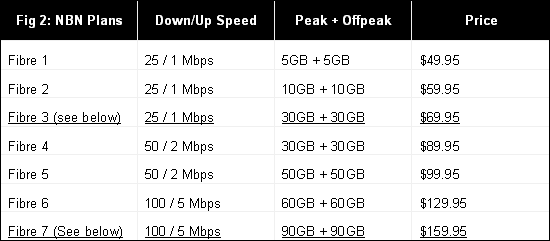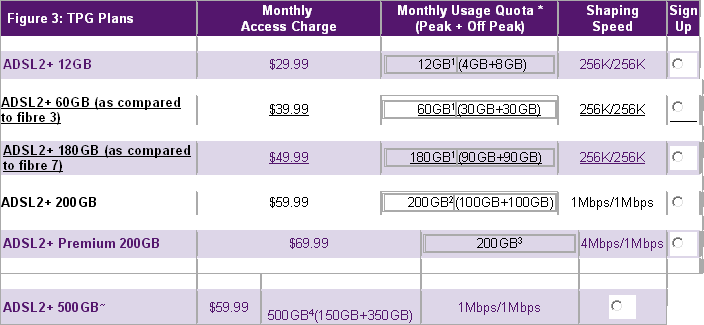Comparison of the pricing of the new capacities compared with what is available today
Given the proposed pricing model for the new NBN (not the introductory offers):

NBN Plans Down/Up Speed Peak + Offpeak Price
Advertisement
The vast majority of consumers would not be considerably better off considering that what they gain in speed they sacrifice in monthly bandwidth compared with existing plans: for example, (TPG available only in the cities)

TPG Plans Monthly
The conclusion would be that where cheap and relatively fast ASDL2+ is available, such as in the higher density cities, there is very little incentive to move to the proposed NBN plans. The take up in small country areas where there are fewer, slower and more expensive internet providers (such as Tasmania) the take up of the NBN plan is likely to be higher. (The quoted figure is 80 per cent at a much reduced introductory price.)
Where are the bottlenecks and can they be upgraded in stages?
There is some confusion as to what constitutes “the network”, and what traffic goes where. The network can simplistically be broken into three distinct areas:
- Major arterial routes between exchanges and the outside world which are presently serviced by microwave, fibre, etc. The limit here places a restriction on the total traffic, and requires bandwidths to be restricted to prevent rush hour freeway type congestions.
- Connection between the exchanges and the junction boxes at the street corners is presently serviced by large multi-pair cables. In the junction box each pair of the multi pair cable is then run separately to each house. The bandwidth is constricted by the sum of the distance from the exchange to the junction box and the junction box to the house.
- Connection between the street corner junction boxes and the home.
Advertisement
The NBN plan is to:
- Upgrade the major arterial routes (estimated cost of $2.4bn). This increases the total combined bandwidth possible at any moment.
- Install fibre from the exchanges to street corner junction boxes (estimated cost of $3.5bn). This removes the length of the copper pair connection from the exchange to the junction box and greatly increases the home capacity. This is obviously better where the distance from the junction box to the house is lower. But gives speeds greater than 12Mbps and as high as 50Mbps.
- Install fibre from the street corner junction boxes to each individual home (estimated cost of $36bn), which removes the final bottle neck in speed and gives the final home speed to 100/1000Mbps.
The alternative plan offered by another party would be to do stages 1 and 2, and to defer stage 3 on a needs basis.
In answer to the question as to whether the NBN plan is required in its entirety, I would have to say that it will be required, but not yet or not even for the next decade.
Discuss in our Forums
See what other readers are saying about this article!
Click here to read & post comments.
40 posts so far.